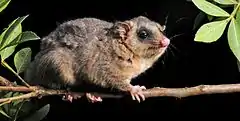| Marmosini | |||
| Hershkovitz, 1992[1] | |||
 Przedstawiciel podrodziny – opośniczek szary (Marmosa paraguayana) | |||
| Systematyka | |||
| Domena | |||
|---|---|---|---|
| Królestwo | |||
| Typ | |||
| Podtyp | |||
| Gromada | |||
| Podgromada | |||
| Nadrząd | |||
| Rząd | |||
| Rodzina | |||
| Podrodzina | |||
| Plemię |
Marmosini | ||
| Typ nomenklatoryczny | |||
|
Marmosa J.E. Gray, 1821 | |||
| Synonimy | |||
| |||
| Rodzaje | |||
| |||
Marmosini – plemię ssaków z podrodziny dydelfów (Didelphinae) w obrębie rodziny dydelfowatych (Didelphidae).
Występowanie
Systematyka
Do plemienia należą następujące występujące współcześnie rodzaje[7][6][8]:
- Marmosa J.E. Gray, 1821 – oposek
- Tlacuatzin Voss & Jansa, 2003 – myszoopos
- Monodelphis Burnett, 1829 – monodelf
Opisano również rodzaj wymarły[9][10]:
- Thylatheridium Reig, 1952
Uwagi
- ↑ Typ nomenklatoryczny: Monodelphis Burnett, 1829; nomen nudum.
- ↑ Nomen nudum.
Przypisy
- 1 2 3 4 P. Hershkovitz. The South American gracile mouse opossums, genus Gracilinanus Gardner and Creighton, 1989 (Marmosidae, Marsupialia): a taxonomic review with notes on general morphology and relationships. „Fieldiana. Zoology”. New series. 39, s. 6, 1992. (ang.).
- ↑ R.V. Tálice, S.L. de Mosera & T. Machado. Observaciones sobre Monodelphis dimidiata. „Actas y Trabajos del Primer Congreso Sudamericano de Zoología”. 4, s. 149, 1961. (hiszp.).
- ↑ O.A. Reig, J.A.W. Kirsch & L.G. Marshall. New conclusions on the relationships of the opossum-like marsupials with an annotated classification of the Didelphimorphia. „Amegbiniana”. 21 (2–4), s. 340, 1985. (ang.).
- ↑ F.J. Goin, Living South American opossums are not living fossils, „Abstracts of the 6th International Theriological Congress”, 1993, s. 112 (ang.).
- 1 2 M.C. McKenna & S.K. Bell: Classification of Mammals: Above the Species Level. New York: Columbia University Press, 1997, s. 70. ISBN 978-0-231-52853-5. (ang.).
- 1 2 C.J. Burgin, D.E. Wilson, R.A. Mittermeier, A.B. Rylands, T.E. Lacher & W. Sechrest: Illustrated Checklist of the Mammals of the World. Cz. 1: Monotremata to Rodentia. Barcelona: Lynx Edicions, 2020, s. 44–49. ISBN 978-84-16728-34-3. (ang.).
- ↑ N. Upham, C. Burgin, J. Widness, M. Becker, C. Parker, S. Liphardt, I. Rochon & D. Huckaby: Treeview of Mammalian Taxonomy Hierarchy. [w:] ASM Mammal Diversity Database (Version 1.11) [on-line]. American Society of Mammalogists. [dostęp 2023-07-16]. (ang.).
- ↑ Nazwy polskie za: W. Cichocki, A. Ważna, J. Cichocki, E. Rajska-Jurgiel, A. Jasiński & W. Bogdanowicz: Polskie nazewnictwo ssaków świata. Warszawa: Muzeum i Instytut Zoologii PAN, 2015, s. 3–4. ISBN 978-83-88147-15-9. (pol. • ang.).
- ↑ J.S. Zijlstra, Marmosini Hershkovitz, 1992, Hesperomys project (Version 23.6.0), DOI: 10.5281/zenodo.7654755 [dostęp 2023-07-16] (ang.).
- ↑ O. Reig. Descripd6n previa de nuevos ungulados y marsupiales fdsiles del Pliocene y del Eocuartario argentinos. „Revista del Museo Municipal de Ciencias Naturales y Traditional de Mar del Plata”. 1, s. 125, 1952. (hiszp.).
This article is issued from Wikipedia. The text is licensed under Creative Commons - Attribution - Sharealike. Additional terms may apply for the media files.